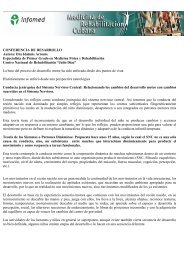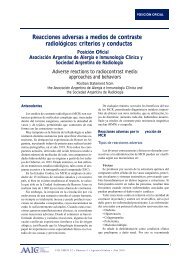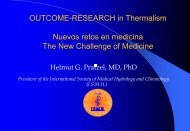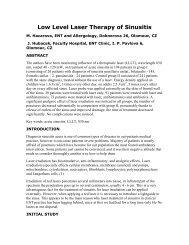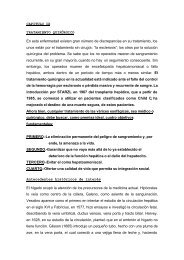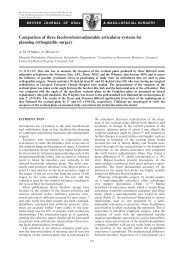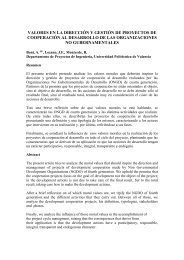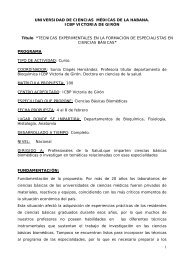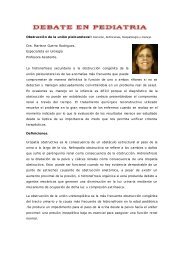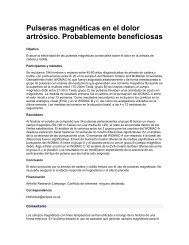pharmacology of medicinal plants and natural products
pharmacology of medicinal plants and natural products
pharmacology of medicinal plants and natural products
Create successful ePaper yourself
Turn your PDF publications into a flip-book with our unique Google optimized e-Paper software.
S98<br />
S. A. DAHANUKAR et al.,<br />
<strong>of</strong> mangrove plant extracts for anti-immunodeficiency<br />
virus activity. HIV infected MT-4 cells were incubated<br />
with the extract <strong>and</strong> anti-viral activity was detected<br />
using tetrazolium-based colorimetric assay. Seven<br />
extracts were found to be effective five <strong>of</strong> which (bark<br />
<strong>of</strong> Rhizophora mucronata <strong>and</strong> leaves <strong>of</strong> Excoecaria<br />
agallocha, Ceriops dec<strong>and</strong>ra, Rhizophora apiculata,<br />
Rhizophora lamarckii) completely inhibited the virus<br />
adsorption to the cells.<br />
14.4. Anti-protozoal agents<br />
14.4.1. Antimalarial :<br />
Ethanolic <strong>and</strong> petroleum extracts <strong>of</strong> Artemisia<br />
japonica, Artemisia maritimia <strong>and</strong> Artemisia<br />
nilegarica were tested for anti-malarial activity, both<br />
in vivo <strong>and</strong> in vitro. In vivo studies were carried out in<br />
Balb/c mice using the Rane test wherein all the compounds<br />
prolonged the survival time <strong>of</strong> the mice. In<br />
vitro, all 3 compounds inhibited schizont maturation<br />
in chloroquine sensitive strains <strong>of</strong> Plasmodium falciparum<br />
182 .<br />
Ball shaped wood scrappings soaked in 5% Neem<br />
oil (Azadirachta indica) diluted in acetone <strong>and</strong> placed<br />
in water storage overhead tanks controlled the breeding<br />
<strong>of</strong> Anopheles stephensi <strong>and</strong> Aedes aegypti in 45<br />
days 183 . Similarly, application <strong>of</strong> a cream <strong>of</strong><br />
Azadirachta indica on exposed body parts at the rate<br />
<strong>of</strong> 2.0 gm/person significantly protected against<br />
Aedes, Culex <strong>and</strong> Anopheles musquitoe bites 184 .<br />
14.4.2. Anti-leishmanial :<br />
The methanolic extract <strong>of</strong> Swertia chirata was found<br />
to inhibit the catalytic activity <strong>of</strong> topoisomerase I enzyme<br />
<strong>of</strong> Leishmania donovani. On subjecting the<br />
extract to fractionation, it yielded 3 secoiridoid<br />
glycosides, amarogentin, amaroswerin <strong>and</strong><br />
sweroside <strong>of</strong> which amacogentin was found to be a<br />
potent inhibitor <strong>of</strong> topoisomerase I <strong>and</strong> exerted its<br />
effect by interacting with the enzyme, thus preventing<br />
binary complex formation 185 .<br />
14.4.3. Anti-trypanosomial<br />
Crude 50% ethanolic extract <strong>of</strong> Parthenium<br />
hysterophorus flowers exhibited trypanocidal activity<br />
against Trypanosoma evansi both in vitro <strong>and</strong> in<br />
vivo. Toxicity was seen only at 1g / kg dose 186 .<br />
14.5. Anthelminthic agents<br />
14.5.1. Anti-Nematodes<br />
Kumar et al 187 has studied the mechanism <strong>of</strong> action<br />
<strong>of</strong> palasonin, the active principle <strong>of</strong> Butea frondosa<br />
seeds on Ascaridia galli. Palasonin inhibited glucose<br />
uptake <strong>and</strong> depleted the glycogen content 187 <strong>and</strong> thus<br />
the possible mechanism <strong>of</strong> its anthelminthic action<br />
may be related to inhibition <strong>of</strong> energy metabolism.<br />
Both aqueous <strong>and</strong> alcoholic extracts <strong>of</strong> the leaves <strong>of</strong><br />
Sencio nudicaulis Buch Ham were found to exert antifilarial<br />
activity when tested against Setaria cervi<br />
(Nematoda Filarioidea). The effective concentrations<br />
differed for the aqueous <strong>and</strong> alcoholic extracts suggesting<br />
the presence <strong>of</strong> a cuticular permeability barrier.<br />
Both extracts also demonstrated micro-filaricidal<br />
action in vitro. Their anti-filarial responses were similar<br />
to diethylcarbamazine in that they too did not block<br />
the stimulant effect <strong>of</strong> acetylcholine on the worm 188 .<br />
Co-administration <strong>of</strong> Regulipid, a herbal formulation,<br />
with diethylcarbamazine therapy to patients suffering<br />
from filariasis was found to decrease chyluria in<br />
these patients 189 .<br />
Mustafa et al 190 injected the excretory-secretory <strong>products</strong><br />
released by the adult Setaria cervi, a bovine<br />
filarial parasite, into rabbits to raise polyvalent antibodies.<br />
These antibodies can be used to detect circulating<br />
antigens in sera by counter immuno-electrophoresis<br />
<strong>and</strong> serve as a diagnostic test for filariasis.<br />
14.5.2. Anti-Trematode (fluke)<br />
The root tuber extract <strong>of</strong> Flemingia vestita, an indigenous<br />
<strong>medicinal</strong> plant in Meghalaya, exhibited antihelminthic<br />
activity in vitro, against 2 species <strong>of</strong> flukes,<br />
Artyfechinostomum sufrartyfex <strong>and</strong> Fasciolopsis<br />
buski. It caused paralysis in both the species. Stereoscanning<br />
observations on the tegumental surfaces<br />
revealed sloughing <strong>of</strong>f <strong>of</strong> most <strong>of</strong> the spines or their<br />
deformation <strong>and</strong> wrinkling <strong>and</strong> rupture <strong>of</strong> the general<br />
tegument 191 .<br />
14.5.3. Agents with molluscicidal activity<br />
The leaf, bark, cake <strong>and</strong> oil <strong>of</strong> Azadirachta indica <strong>and</strong><br />
synthetic pesticides derived from the plant demonstrated<br />
both, dose <strong>and</strong> time dependent, molluscicidal<br />
activity when tested against the snails, Lymnaea




